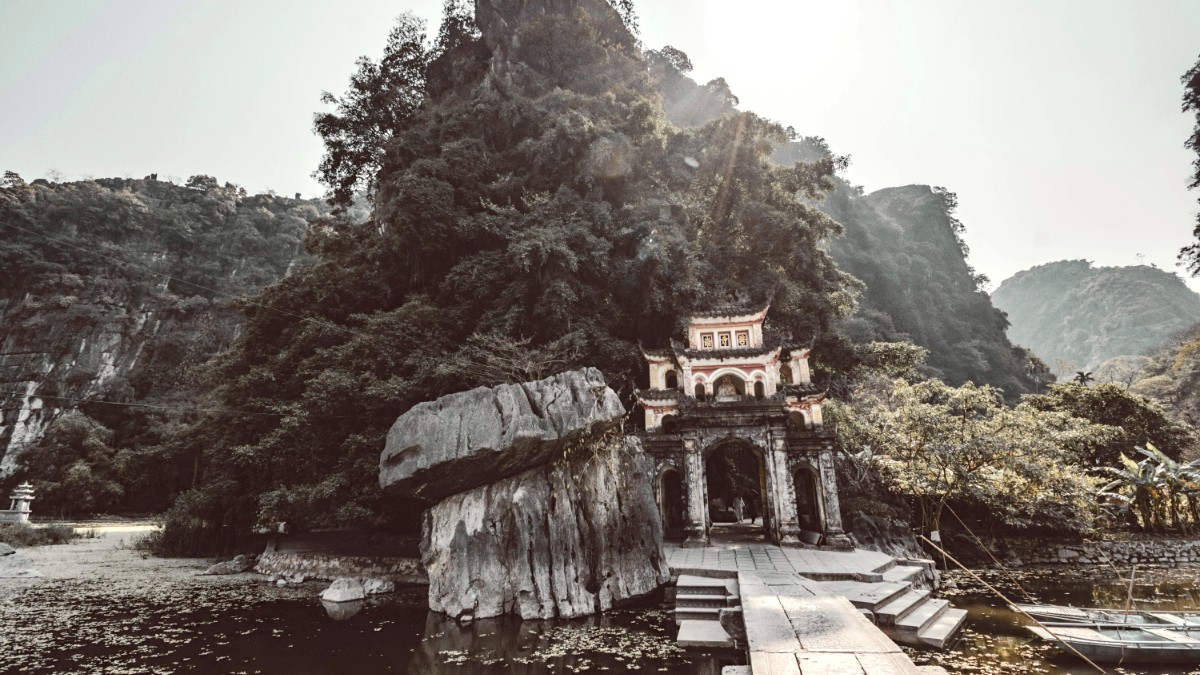
North Central Vietnam, Vietnam
The province covers an area of around 1,387 square kilometers, or 536 square miles. Its landscape displays a mix of dramatic limestone karsts, vast rice paddies, meandering rivers, and coastal stretches. This unique geography forms a diverse environment, offering both dramatic mountain views and peaceful waterways. The geological formations here resemble those found in Ha Long Bay, but they rise from the land, forming a distinct and equally impressive scenery. Rivers like the Ngo Dong flow through the landscape, carving paths through the rock and feeding the fertile paddies. This combination of land and water elements shapes the region's character and generates unique travel experiences.
Ninh Binh lies a short distance south of Hanoi, making it an accessible destination for a day trip or an extended stay.
Travel time typically ranges from 1.5 to 2.5 hours by road or rail, presenting a straightforward journey from the capital.
Ninh Binh is a special place in Vietnamese history. It served as the ancient capital of Vietnam during two important dynasties: the Dinh Dynasty (968–980 AD) and the Early Le Dynasty (980–1009 AD). This period centered around Hoa Lu, a site within present-day Ninh Binh. The establishment of Hoa Lu as the capital marked a pivotal moment, as it symbolized the successful assertion of an independent Vietnamese feudal state. This independence came after a millennium of Chinese rule. The Dinh and Early Le dynasties shaped future Vietnamese imperial power.
Its natural defenses, formed by the limestone mountains and intricate waterways, afforded protection and rendered it a difficult area for invaders to conquer. Many temples and relics from these ancient dynasties remain, providing a tangible link to this important past. These sites permit visitors to walk through history, imagining the lives of emperors and the challenges faced by an emerging nation. The historical echoes found in Ninh Binh deepen its natural beauty, forming a destination appealing to both nature enthusiasts and history buffs. Visitors can explore the temples, learn about the emperors, and appreciate the resilience of the Vietnamese people who shaped their nation from this very ground.
Site of the Dinh and Early Le Dynasties.
period of Vietnamese independence.
Continuation of early imperial rule.
Temples and structures dating back over 1000 years.
Natural defenses offered protection from invaders.
The historical legacy of Ninh Binh, notably its time as the capital, sets it apart as a region of profound national importance. Visitors experience a blend of natural wonder and deep historical roots.
The province's history as an imperial center shaped its identity and laid foundations for Vietnam's independent future. Evidence of these early kingdoms dots the landscape.
Efforts to preserve the historical sites allow current generations and visitors to connect with the nation's origins and the resilience of its people.
Ninh Binh: A landscape where nature's grandeur meets the echoes of ancient dynasties.
Ninh Binh gains recognition as a popular tourist destination. It is often described as "Ha Long Bay on land." This comparison derives from its similar karst formations that rise majestically from the earth. The region presents a quieter, more grounded alternative to the famous bay, making closer interaction with nature and local life possible.
Several attractions draw visitors here. The Trang An Scenic Landscape Complex, an UNESCO World Heritage Site, is a highlight of the region. This complex includes winding rivers, numerous caves, and lush valleys, traversed by traditional boat tours. Tam Coc – Bich Dong offers another iconic boat trip through caves and past rice paddies, with postcard-perfect views. Mua Cave permits a rewarding climb to a panoramic viewpoint, displaying sweeping vistas of the "Ha Long Bay on land" scenery. The ancient capital of Hoa Lu preserves the remnants of Vietnam's early independent state, with temples dedicated to past emperors.
Karst landscapes, caves, and rice paddies define the provincial scenery.
Past as an ancient capital with surviving temples and relics.
Daily life intertwined with agriculture and a growing tourism industry.
The main economic activities in Ninh Binh include agriculture, specifically rice cultivation, which shapes much of the landscape. Tourism also contributes significantly to the local economy, with a growing number of homestays, restaurants, and tour operators. Aquaculture, especially in the coastal and wetland areas, adds another layer to the province's economic foundation.
A vast complex of limestone mountains, valleys, and rivers. Explore via traditional sampan boat tours through caves and past temples.
Known as "Ha Long Bay on land," this site features three caves (Tam Coc) traversed by boat, surrounded by rice paddies. Bich Dong Pagoda is a nearby cave temple.
The former capital of Vietnam in the 10th and 11th centuries, home to temples dedicated to the Dinh and Le Dynasties.
Venture into less-explored villages for authentic local life, observe farming practices, and interact with residents.
Savor local specialties like "Com Chay" (burnt rice crust) and goat meat dishes, distinct to Ninh Binh.
The varied landscapes, from rice fields to limestone peaks, provide endless opportunities for photographers, especially during sunrise or sunset.